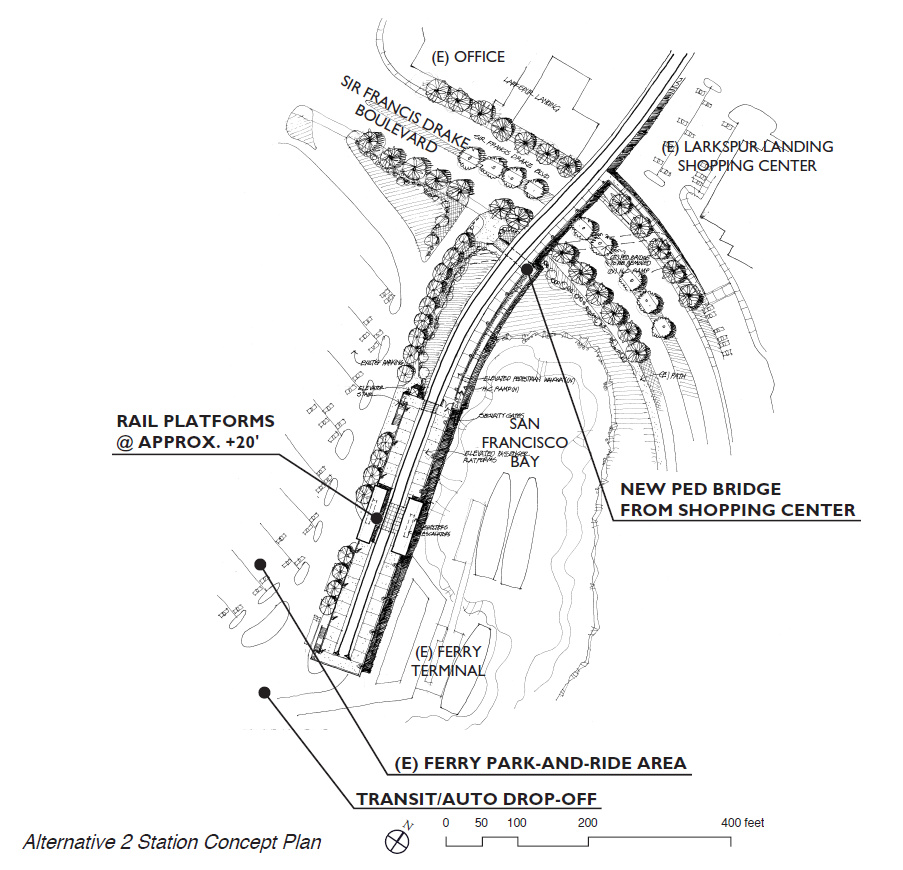 While Sonoma gets to reap the benefits of SMART, including a $15 million expansion of the IOS to the Santa Rosa Airport, Marin’s commuting public rightly grouses that it doesn’t serve their needs. Yet by ignoring Larkspur Landing for now, SMART has a chance to do what it should have done from the start and plan for a station in the ferry terminal.
While Sonoma gets to reap the benefits of SMART, including a $15 million expansion of the IOS to the Santa Rosa Airport, Marin’s commuting public rightly grouses that it doesn’t serve their needs. Yet by ignoring Larkspur Landing for now, SMART has a chance to do what it should have done from the start and plan for a station in the ferry terminal.
A core principal of transit planning is connectivity. Any network is only as good as the strength of its connections, and transit is not excluded. The strongest sort of transit connection is the cross-platform connection, which allows you to hop off your train or bus, cross the platform to your transfer and be on your way. It's like switching planes in an airport by walking one gate over.
In contrast, a weak transit connection forces riders to leave one station, walk a couple of blocks, and enter another station. Rather than boarding a connecting flight at the gate next to yours, we need to hike across the airport to another terminal entirely. Though this may be tolerable once in a while, as a daily commute it can crush even the hardiest transit enthusiast.
Sadly, SMART has opted against convenience and in favor of soul-crushing. Current plans call for locating the ferry station a half mile from the ferry terminal, requiring transferring riders to either walk along parking lots and unfriendly streets or wait around for a shuttle. A commute that might already involve 2 transfers will become one involving 3.
Larkspur residents, most of whom who won't even get direct SMART access, rightly complain that this makes little sense. The Station Area Plan for the Larkspur Landing neighborhood calls for relocating the station into the terminal and decries the poor site chosen by the SMART board.
SMART's draft environmental impact report contained a draft plan (very large PDF) to put the station in the ferry terminal. Back when station sites were being planned, staff created four alternate proposals for Larkspur, including two with better access to the ferry. The best one placed the station adjacent to the current terminal entrance at the end of a half-mile of elevated track. Given the current going rate for elevated rail, this option would cost about $30 million plus land acquisition costs. That’s about one-fifth the cost of the Greenbrae Interchange Project next door.
Yet at the request of the Larkspur City Council (PDF), SMART went for the station plan staff explicitly recommended against. The city complained that the removal of two buildings would require modifying the plan that governs Marin Country Mart, and that an elevated rail line would obstruct views of the Bay. They also were concerned about cost, though Larkspur wouldn't need to pay for the extension. Another concern raised earlier by staff is that a station in the ferry terminal would make extensions to Corte Madera or San Quentin more difficult.
Though these concerns are well-intentioned and should be addressed in any plan to relocate the station, it's foolish to scuttle a dramatic service improvement over parking lots and fantasy expansions that are decades from reality.
And here is where we have a new opportunity. By splitting construction of the line in two, SMART has given Larkspur residents a chance to change that seven-year-old bad decision. Nobody likes to run across an airport to catch a plane, and no commuter likes to walk across a half-mile of parking lots and traffic to make a transfer. Larkspur needs reverse its earlier request and demand a world-class transit connection, and residents should ask for the same. And SMART should listen.
Next time, I'll examine the city council's original concerns and how they might be addressed.